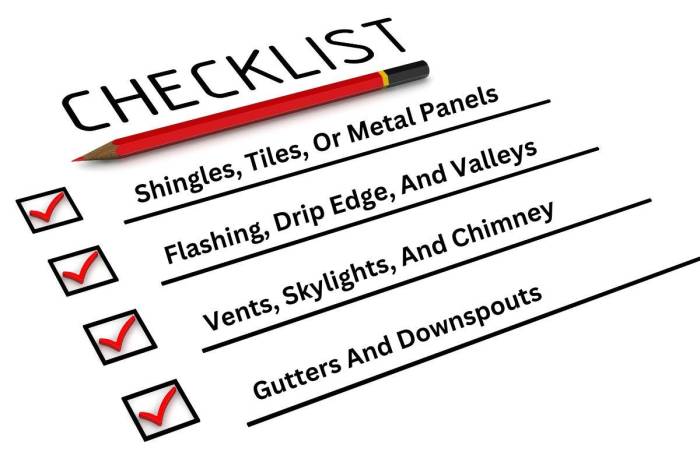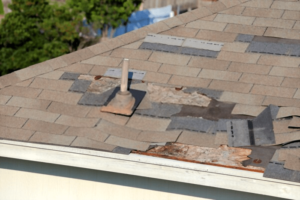
Roof inspection checklist for homeowners is a vital resource that every property owner should have at their fingertips. Regular inspections not only preserve the integrity of your home but also elevate its value and security. With various roofing materials and seasonal challenges, understanding what to look for during roof inspections is crucial for maintaining a safe and comfortable living environment.
This guide will walk you through essential components to include in your checklist, offer effective seasonal maintenance tips, and highlight the connection between a well-maintained roof and home security. From shingles to drainage systems, we’ll cover all the bases to ensure you’re well-prepared for any roofing challenge.
Roof Inspection Checklist Components
Conducting a roof inspection is a vital practice for homeowners, ensuring the longevity and safety of their homes. A well-thought-out checklist can simplify the process, allowing homeowners to systematically assess their roofs. By focusing on essential components, homeowners can identify potential issues before they escalate into costly repairs.Different roofing materials play a significant role in the inspection process, as each type has unique characteristics and maintenance requirements.
Understanding these differences allows homeowners to tailor their inspections more effectively, ensuring no critical area is overlooked.
Essential Elements of a Roof Inspection Checklist
A comprehensive roof inspection checklist should encompass various aspects to ensure a thorough evaluation. This includes checking for visible damage, assessing drainage systems, and evaluating the overall condition of roofing materials. The following components are crucial for an effective roof inspection:
- Visual Inspection: Begin with a thorough visual assessment of the roof from the ground and, if safe, from a ladder. Look for missing or damaged shingles, tiles, or other roofing materials.
- Gutters and Downspouts: Ensure gutters are free of debris and properly directing water away from the foundation. Clogged gutters can lead to water damage.
- Flashing and Seals: Check around chimneys, vents, and skylights for intact flashing and seals. Deterioration here can lead to leaks.
- Attic Inspection: Look inside the attic for signs of moisture or leaks, which may indicate roof issues.
- Roof Age and Material: Note the age and type of roofing material, as different materials have varying lifespans and maintenance needs.
Significance of Different Roofing Materials
The roofing material significantly influences the inspection process, as various materials come with distinct characteristics. For instance, asphalt shingles typically last 15-30 years, while metal roofs can last 50 years or more. It is essential to consider the following when inspecting different roofing materials:
- Asphalt Shingles: Check for curling, cracking, or granule loss, indicating the need for replacement.
- Wood Shakes: Look for signs of rot or insect damage, as these materials are more susceptible to decay.
- Metal Roofing: Inspect for rust, dents, and loose seams, as these can compromise the roof’s integrity.
- Tile and Slate: Ensure tiles are not cracked or broken; these materials can be heavier and may require specialized support.
Method for Checking the Condition of Shingles or Tiles
Inspecting shingles or tiles is a critical aspect of roof maintenance. Homeowners should approach this task systematically to assess their condition adequately. The following method Artikels how to check shingles or tiles effectively:
1. Visual Inspection
Start from the ground to evaluate the overall appearance of the roof. Check for missing, cracked, or curling shingles.
2. Use a Ladder Safely
If comfortable, use a ladder to get a closer look at the roof surface. Avoid stepping directly on shingles to prevent damage.
3. Check for Granule Loss
Inspect the gutters for granules, which may indicate shingle wear. Less granulation can lead to reduced lifespan.
4. Assess the Edges
Pay special attention to the edges of shingles or tiles. Damage often begins here, leading to leaks if not addressed.
5. Look for Algae or Moss
While not immediately harmful, algae or moss can retain moisture and lead to shingle deterioration over time.
6. Evaluate Flashing
Ensure that flashing is intact and properly sealed, as this is a common leak point.By following this method, homeowners can effectively assess the condition of their roofing materials, allowing for timely repairs and maintenance.
Seasonal Roof Maintenance Tips

Maintaining your roof throughout the changing seasons is essential to prolong its lifespan and ensure its effectiveness in protecting your home. Each season brings specific challenges that can affect your roof’s condition, and understanding how to prepare for these changes can save you from costly repairs down the road. By adopting a proactive maintenance approach, homeowners can preserve the integrity of their roofs and prevent potential issues from escalating.During the various seasons, there are practical strategies to maintain your roof effectively.
Preventative measures, such as regular inspections and timely repairs, can significantly reduce the risk of water damage, leaks, and other roof-related problems. One vital aspect of roof maintenance is assessing the roof drainage systems, which play a crucial role in keeping your roof in good shape. Poor drainage can lead to water pooling, causing leaks and structural damage.
Winter Roof Maintenance
As winter approaches, it is vital to prepare your roof for snow and ice accumulation. Ice dams can form on the edges of the roof, trapping water and leading to leaks inside your home. Here are some strategies for maintaining your roof during the winter months:
- Remove snow buildup regularly to prevent ice dams from forming.
- Inspect and clean gutters to ensure proper drainage before snow falls.
- Check for any loose shingles or damaged flashing that may need to be repaired.
Spring Roof Maintenance
Spring is the perfect time to tackle roof maintenance tasks that may have been neglected during the winter. As the weather warms up, it’s essential to inspect for damage caused by winter storms. Consider the following tips:
- Conduct a thorough inspection of the roof for missing or damaged shingles.
- Clear debris from gutters and downspouts to prevent water pooling.
- Examine the flashing around chimneys and vents for any signs of wear.
Summer Roof Maintenance
Summer’s warm weather provides an excellent opportunity for homeowners to perform more in-depth roof maintenance. High temperatures can lead to roof materials expanding, which may create vulnerabilities. Here’s how to maintain your roof during summer:
- Inspect for any signs of blistering or cracking in roofing materials.
- Ensure that tree branches are trimmed back to prevent damage from falling limbs.
- Check attic insulation and ventilation to reduce heat buildup and moisture issues.
Fall Roof Maintenance
As autumn arrives, preparing your roof for the impending winter is crucial. Leaves can clog gutters and lead to drainage issues if not addressed. Here are some effective fall maintenance tips:
- Clean gutters and downspouts to ensure clear water flow.
- Inspect roof shingles for signs of wear and replace any damaged ones.
- Perform a final check on flashing and sealant around vents and chimneys.
Regular roof maintenance throughout the seasons not only extends the life of your roof but also enhances your home’s overall value and safety.
Home Security Considerations Related to Roofing
A well-maintained roof is more than just a protective covering for your home; it plays a crucial role in your overall security. An intact roof not only shields your home from the elements but also deters potential intruders. Recognizing the relationship between roof maintenance and home security is essential for homeowners looking to protect their families and belongings.Maintaining your roof contributes significantly to the security of your home.
When roofs are in poor condition, they may have vulnerabilities that can be exploited by unauthorized individuals. For example, broken shingles, loose tiles, or gaps can serve as entry points. Regular roof inspections help identify and rectify these issues before they compromise your home’s security. By ensuring that your roof is secure, you minimize the risk of break-ins and theft, giving you peace of mind.
Secure Roofing Elements and Potential Vulnerabilities
Understanding what makes a roof secure can help homeowners pinpoint weaknesses that could jeopardize their safety. Below is a checklist comparing secure roofing elements against common vulnerabilities to consider during inspections.To effectively assess your roof’s security, consider the following aspects:
| Secure Roofing Elements | Potential Vulnerabilities |
|---|---|
| Sturdy shingles or tiles that are in good condition | Cracked or missing shingles that can expose the roof decking |
| Well-sealed flashing around chimneys and vents | Loose or corroded flashing that can allow water and pests to enter |
| Secure roof access points, like hatches or ladders | Accessible ladders or tree branches that provide easy entry |
| Proper insulation and ventilation that prevent moisture build-up | Moisture damage leading to weakened roof structure |
| Regular inspections and maintenance logs | Neglected maintenance that results in undetected damage |
These elements highlight the importance of regular roof inspections. By ensuring that secure roofing features are intact and addressing any vulnerabilities, homeowners can significantly enhance the safety of their homes against unauthorized access and weather-related damage.
Ending Remarks

In summary, having a comprehensive roof inspection checklist for homeowners is essential for sustaining your home’s value and safety. By understanding both the preventive measures needed throughout the seasons and the unique characteristics of your roofing materials, you can significantly reduce the risk of costly repairs and enhance your home’s security. Regular inspections empower homeowners to take proactive steps in maintaining their roofs, ultimately leading to a more secure and resilient living space.
Clarifying Questions
How often should I inspect my roof?
It is recommended to inspect your roof at least twice a year, ideally in spring and fall, as well as after severe weather events.
What should I do if I find damage during an inspection?
If you find damage, promptly contact a professional roofer to assess the situation and recommend necessary repairs.
Can I do a roof inspection myself?
Yes, homeowners can perform basic inspections, but it’s advisable to have a professional check for more in-depth issues, especially on steep roofs.
What are signs of roof wear and tear?
Signs include missing shingles, sagging areas, water stains on ceilings, and granules in gutters.
How does a roof affect home insurance?
A well-maintained roof can lower insurance premiums and is crucial for claims related to roof damage.






